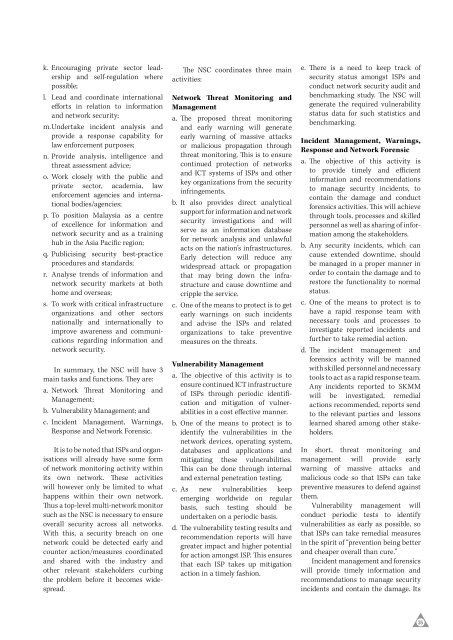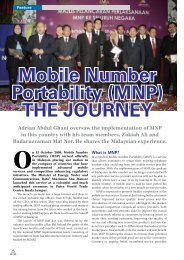The SKMM Network Security Centre - my Convergence Magazine
The SKMM Network Security Centre - my Convergence Magazine
The SKMM Network Security Centre - my Convergence Magazine
Create successful ePaper yourself
Turn your PDF publications into a flip-book with our unique Google optimized e-Paper software.
k. Encouraging private sector leadership<br />
and self-regulation where<br />
possible;<br />
l. Lead and coordinate international<br />
efforts in relation to information<br />
and network security;<br />
m. Undertake incident analysis and<br />
provide a response capability for<br />
law enforcement purposes;<br />
n. Provide analysis, intelligence and<br />
threat assessment advice;<br />
o. Work closely with the public and<br />
private sector, academia, law<br />
enforcement agencies and international<br />
bodies/agencies;<br />
p. To position Malaysia as a centre<br />
of excellence for information and<br />
network security and as a training<br />
hub in the Asia Pacific region;<br />
q. Publicising security best-practice<br />
procedures and standards;<br />
r. Analyse trends of information and<br />
network security markets at both<br />
home and overseas;<br />
s. To work with critical infrastructure<br />
organizations and other sectors<br />
nationally and internationally to<br />
improve awareness and communications<br />
regarding information and<br />
network security.<br />
In summary, the NSC will have 3<br />
main tasks and functions. <strong>The</strong>y are:<br />
a. <strong>Network</strong> Threat Monitoring and<br />
Management;<br />
b. Vulnerability Management; and<br />
c. Incident Management, Warnings,<br />
Response and <strong>Network</strong> Forensic.<br />
It is to be noted that ISPs and organisations<br />
will already have some form<br />
of network monitoring activity within<br />
its own network. <strong>The</strong>se activities<br />
will however only be limited to what<br />
happens within their own network.<br />
Thus a top-level multi-network monitor<br />
such as the NSC is necessary to ensure<br />
overall security across all networks.<br />
With this, a security breach on one<br />
network could be detected early and<br />
counter action/measures coordinated<br />
and shared with the industry and<br />
other relevant stakeholders curbing<br />
the problem before it becomes widespread.<br />
<strong>The</strong> NSC coordinates three main<br />
activities:<br />
<strong>Network</strong> Threat Monitoring and<br />
Management<br />
a. <strong>The</strong> proposed threat monitoring<br />
and early warning will generate<br />
early warning of massive attacks<br />
or malicious propagation through<br />
threat monitoring. This is to ensure<br />
continued protection of networks<br />
and ICT systems of ISPs and other<br />
key organizations from the security<br />
infringements.<br />
b. It also provides direct analytical<br />
support for information and network<br />
security investigations and will<br />
serve as an information database<br />
for network analysis and unlawful<br />
acts on the nation’s infrastructures.<br />
Early detection will reduce any<br />
widespread attack or propagation<br />
that may bring down the infrastructure<br />
and cause downtime and<br />
cripple the service.<br />
c. One of the means to protect is to get<br />
early warnings on such incidents<br />
and advise the ISPs and related<br />
organizations to take preventive<br />
measures on the threats.<br />
Vulnerability Management<br />
a. <strong>The</strong> objective of this activity is to<br />
ensure continued ICT infrastructure<br />
of ISPs through periodic identification<br />
and mitigation of vulnerabilities<br />
in a cost effective manner.<br />
b. One of the means to protect is to<br />
identify the vulnerabilities in the<br />
network devices, operating system,<br />
databases and applications and<br />
mitigating these vulnerabilities.<br />
This can be done through internal<br />
and external penetration testing.<br />
c. As new vulnerabilities keep<br />
emerging worldwide on regular<br />
basis, such testing should be<br />
undertaken on a periodic basis.<br />
d. <strong>The</strong> vulnerability testing results and<br />
recommendation reports will have<br />
greater impact and higher potential<br />
for action amongst ISP. This ensures<br />
that each ISP takes up mitigation<br />
action in a timely fashion.<br />
e. <strong>The</strong>re is a need to keep track of<br />
security status amongst ISPs and<br />
conduct network security audit and<br />
benchmarking study. <strong>The</strong> NSC will<br />
generate the required vulnerability<br />
status data for such statistics and<br />
benchmarking.<br />
Incident Management, Warnings,<br />
Response and <strong>Network</strong> Forensic<br />
a. <strong>The</strong> objective of this activity is<br />
to provide timely and efficient<br />
information and recommendations<br />
to manage security incidents, to<br />
contain the damage and conduct<br />
forensics activities. This will achieve<br />
through tools, processes and skilled<br />
personnel as well as sharing of information<br />
among the stakeholders.<br />
b. Any security incidents, which can<br />
cause extended downtime, should<br />
be managed in a proper manner in<br />
order to contain the damage and to<br />
restore the functionality to normal<br />
status.<br />
c. One of the means to protect is to<br />
have a rapid response team with<br />
necessary tools and processes to<br />
investigate reported incidents and<br />
further to take remedial action.<br />
d. <strong>The</strong> incident management and<br />
forensics activity will be manned<br />
with skilled personnel and necessary<br />
tools to act as a rapid response team.<br />
Any incidents reported to <strong>SKMM</strong><br />
will be investigated, remedial<br />
actions recommended, reports send<br />
to the relevant parties and lessons<br />
learned shared among other stakeholders.<br />
In short, threat monitoring and<br />
management will provide early<br />
warning of massive attacks and<br />
malicious code so that ISPs can take<br />
preventive measures to defend against<br />
them.<br />
Vulnerability management will<br />
conduct periodic tests to identify<br />
vulnerabilities as early as possible, so<br />
that ISPs can take remedial measures<br />
in the spirit of “prevention being better<br />
and cheaper overall than cure.”<br />
Incident management and forensics<br />
will provide timely information and<br />
recommendations to manage security<br />
incidents and contain the damage. Its<br />
35














